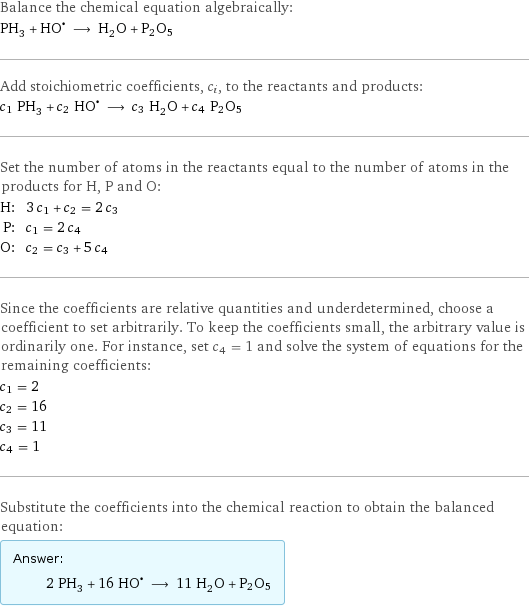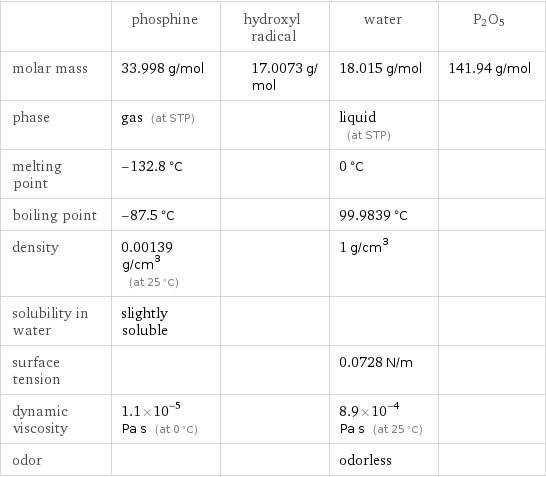Input interpretation

PH_3 phosphine + (HO)^• hydroxyl radical ⟶ H_2O water + P2O5
Balanced equation

Balance the chemical equation algebraically: PH_3 + (HO)^• ⟶ H_2O + P2O5 Add stoichiometric coefficients, c_i, to the reactants and products: c_1 PH_3 + c_2 HO^• ⟶ c_3 H_2O + c_4 P2O5 Set the number of atoms in the reactants equal to the number of atoms in the products for H, P and O: H: | 3 c_1 + c_2 = 2 c_3 P: | c_1 = 2 c_4 O: | c_2 = c_3 + 5 c_4 Since the coefficients are relative quantities and underdetermined, choose a coefficient to set arbitrarily. To keep the coefficients small, the arbitrary value is ordinarily one. For instance, set c_4 = 1 and solve the system of equations for the remaining coefficients: c_1 = 2 c_2 = 16 c_3 = 11 c_4 = 1 Substitute the coefficients into the chemical reaction to obtain the balanced equation: Answer: | | 2 PH_3 + 16 HO^• ⟶ 11 H_2O + P2O5
Structures

+ (HO)^• ⟶ + P2O5
Names

phosphine + hydroxyl radical ⟶ water + P2O5
Equilibrium constant
![Construct the equilibrium constant, K, expression for: PH_3 + (HO)^• ⟶ H_2O + P2O5 Plan: • Balance the chemical equation. • Determine the stoichiometric numbers. • Assemble the activity expression for each chemical species. • Use the activity expressions to build the equilibrium constant expression. Write the balanced chemical equation: 2 PH_3 + 16 HO^• ⟶ 11 H_2O + P2O5 Assign stoichiometric numbers, ν_i, using the stoichiometric coefficients, c_i, from the balanced chemical equation in the following manner: ν_i = -c_i for reactants and ν_i = c_i for products: chemical species | c_i | ν_i PH_3 | 2 | -2 HO^• | 16 | -16 H_2O | 11 | 11 P2O5 | 1 | 1 Assemble the activity expressions accounting for the state of matter and ν_i: chemical species | c_i | ν_i | activity expression PH_3 | 2 | -2 | ([PH3])^(-2) HO^• | 16 | -16 | ([HO•])^(-16) H_2O | 11 | 11 | ([H2O])^11 P2O5 | 1 | 1 | [P2O5] The equilibrium constant symbol in the concentration basis is: K_c Mulitply the activity expressions to arrive at the K_c expression: Answer: | | K_c = ([PH3])^(-2) ([HO•])^(-16) ([H2O])^11 [P2O5] = (([H2O])^11 [P2O5])/(([PH3])^2 ([HO•])^16)](../image_source/cd701fec6dfea9a61ce5d83ff635f683.png)
Construct the equilibrium constant, K, expression for: PH_3 + (HO)^• ⟶ H_2O + P2O5 Plan: • Balance the chemical equation. • Determine the stoichiometric numbers. • Assemble the activity expression for each chemical species. • Use the activity expressions to build the equilibrium constant expression. Write the balanced chemical equation: 2 PH_3 + 16 HO^• ⟶ 11 H_2O + P2O5 Assign stoichiometric numbers, ν_i, using the stoichiometric coefficients, c_i, from the balanced chemical equation in the following manner: ν_i = -c_i for reactants and ν_i = c_i for products: chemical species | c_i | ν_i PH_3 | 2 | -2 HO^• | 16 | -16 H_2O | 11 | 11 P2O5 | 1 | 1 Assemble the activity expressions accounting for the state of matter and ν_i: chemical species | c_i | ν_i | activity expression PH_3 | 2 | -2 | ([PH3])^(-2) HO^• | 16 | -16 | ([HO•])^(-16) H_2O | 11 | 11 | ([H2O])^11 P2O5 | 1 | 1 | [P2O5] The equilibrium constant symbol in the concentration basis is: K_c Mulitply the activity expressions to arrive at the K_c expression: Answer: | | K_c = ([PH3])^(-2) ([HO•])^(-16) ([H2O])^11 [P2O5] = (([H2O])^11 [P2O5])/(([PH3])^2 ([HO•])^16)
Rate of reaction
![Construct the rate of reaction expression for: PH_3 + (HO)^• ⟶ H_2O + P2O5 Plan: • Balance the chemical equation. • Determine the stoichiometric numbers. • Assemble the rate term for each chemical species. • Write the rate of reaction expression. Write the balanced chemical equation: 2 PH_3 + 16 HO^• ⟶ 11 H_2O + P2O5 Assign stoichiometric numbers, ν_i, using the stoichiometric coefficients, c_i, from the balanced chemical equation in the following manner: ν_i = -c_i for reactants and ν_i = c_i for products: chemical species | c_i | ν_i PH_3 | 2 | -2 HO^• | 16 | -16 H_2O | 11 | 11 P2O5 | 1 | 1 The rate term for each chemical species, B_i, is 1/ν_i(Δ[B_i])/(Δt) where [B_i] is the amount concentration and t is time: chemical species | c_i | ν_i | rate term PH_3 | 2 | -2 | -1/2 (Δ[PH3])/(Δt) HO^• | 16 | -16 | -1/16 (Δ[HO•])/(Δt) H_2O | 11 | 11 | 1/11 (Δ[H2O])/(Δt) P2O5 | 1 | 1 | (Δ[P2O5])/(Δt) (for infinitesimal rate of change, replace Δ with d) Set the rate terms equal to each other to arrive at the rate expression: Answer: | | rate = -1/2 (Δ[PH3])/(Δt) = -1/16 (Δ[HO•])/(Δt) = 1/11 (Δ[H2O])/(Δt) = (Δ[P2O5])/(Δt) (assuming constant volume and no accumulation of intermediates or side products)](../image_source/b631ea3a35ff973eef1c8e8d8c9890e1.png)
Construct the rate of reaction expression for: PH_3 + (HO)^• ⟶ H_2O + P2O5 Plan: • Balance the chemical equation. • Determine the stoichiometric numbers. • Assemble the rate term for each chemical species. • Write the rate of reaction expression. Write the balanced chemical equation: 2 PH_3 + 16 HO^• ⟶ 11 H_2O + P2O5 Assign stoichiometric numbers, ν_i, using the stoichiometric coefficients, c_i, from the balanced chemical equation in the following manner: ν_i = -c_i for reactants and ν_i = c_i for products: chemical species | c_i | ν_i PH_3 | 2 | -2 HO^• | 16 | -16 H_2O | 11 | 11 P2O5 | 1 | 1 The rate term for each chemical species, B_i, is 1/ν_i(Δ[B_i])/(Δt) where [B_i] is the amount concentration and t is time: chemical species | c_i | ν_i | rate term PH_3 | 2 | -2 | -1/2 (Δ[PH3])/(Δt) HO^• | 16 | -16 | -1/16 (Δ[HO•])/(Δt) H_2O | 11 | 11 | 1/11 (Δ[H2O])/(Δt) P2O5 | 1 | 1 | (Δ[P2O5])/(Δt) (for infinitesimal rate of change, replace Δ with d) Set the rate terms equal to each other to arrive at the rate expression: Answer: | | rate = -1/2 (Δ[PH3])/(Δt) = -1/16 (Δ[HO•])/(Δt) = 1/11 (Δ[H2O])/(Δt) = (Δ[P2O5])/(Δt) (assuming constant volume and no accumulation of intermediates or side products)
Chemical names and formulas

| phosphine | hydroxyl radical | water | P2O5 formula | PH_3 | (HO)^• | H_2O | P2O5 Hill formula | H_3P | | H_2O | O5P2 name | phosphine | hydroxyl radical | water |
Substance properties

| phosphine | hydroxyl radical | water | P2O5 molar mass | 33.998 g/mol | 17.0073 g/mol | 18.015 g/mol | 141.94 g/mol phase | gas (at STP) | | liquid (at STP) | melting point | -132.8 °C | | 0 °C | boiling point | -87.5 °C | | 99.9839 °C | density | 0.00139 g/cm^3 (at 25 °C) | | 1 g/cm^3 | solubility in water | slightly soluble | | | surface tension | | | 0.0728 N/m | dynamic viscosity | 1.1×10^-5 Pa s (at 0 °C) | | 8.9×10^-4 Pa s (at 25 °C) | odor | | | odorless |
Units
